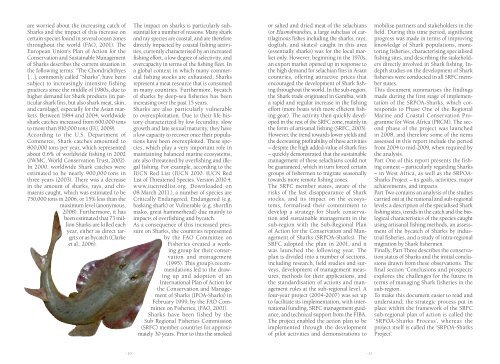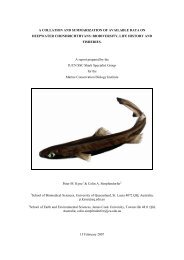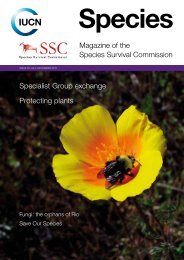30 Years of shark fishing in west africa - Shark Specialist Group
30 Years of shark fishing in west africa - Shark Specialist Group
30 Years of shark fishing in west africa - Shark Specialist Group
You also want an ePaper? Increase the reach of your titles
YUMPU automatically turns print PDFs into web optimized ePapers that Google loves.
are worried about the <strong>in</strong>creas<strong>in</strong>g catch <strong>of</strong><br />
<strong>Shark</strong>s and the impact <strong>of</strong> this <strong>in</strong>crease on<br />
certa<strong>in</strong> species found <strong>in</strong> several ocean zones<br />
throughout the world (FAO, 2001). The<br />
European Union's Plan <strong>of</strong> Action for the<br />
Conservation and Susta<strong>in</strong>able Management<br />
<strong>of</strong> <strong>Shark</strong>s describes the current situation <strong>in</strong><br />
the follow<strong>in</strong>g terms: “The Chondrichthyes<br />
[…], commonly called “<strong>Shark</strong>s”, have been<br />
subject to <strong>in</strong>creas<strong>in</strong>gly <strong>in</strong>tensive <strong>fish<strong>in</strong>g</strong><br />
practices s<strong>in</strong>ce the middle <strong>of</strong> 1980s, due to<br />
higher demand for <strong>Shark</strong> products (<strong>in</strong> particular<br />
<strong>shark</strong> f<strong>in</strong>s, but also <strong>shark</strong> meat, sk<strong>in</strong>,<br />
and cartilage), especially for the Asian markets.<br />
Between 1984 and 2004, worldwide<br />
<strong>shark</strong> catches <strong>in</strong>creased from 600,000 tons<br />
to more than 810,000 tons (EU, 2009).<br />
Accord<strong>in</strong>g to the U.S. Department <strong>of</strong><br />
Commerce, <strong>Shark</strong> catches amounted to<br />
800,000 tons per year, which represented<br />
about 0.6% <strong>of</strong> worldwide <strong>fish<strong>in</strong>g</strong> <strong>in</strong> 2002<br />
(IWMC, World Conservation Trust, 2002).<br />
In 2000, worldwide <strong>Shark</strong> catches were<br />
estimated to be nearly 900,000 tons <strong>in</strong><br />
three years (2003). There was a decrease<br />
<strong>in</strong> the amount <strong>of</strong> <strong>shark</strong>s, rays, and chimaeras<br />
caught, which was estimated to be<br />
750,000 tons <strong>in</strong> 2006, or 15% less than the<br />
maximum level (anonymous,<br />
2008). Furthermore, it has<br />
been estimated that 73 million<br />
<strong>Shark</strong>s are killed each<br />
year, either as direct targets<br />
or as bycatch (Clarke<br />
et al., 2006).<br />
The impact on <strong>shark</strong>s is particularly substantial<br />
for a number <strong>of</strong> reasons. Many <strong>shark</strong><br />
and ray species are coastal, and are therefore<br />
directly impacted by coastal <strong>fish<strong>in</strong>g</strong> activities,<br />
currently characterised by an <strong>in</strong>creased<br />
<strong>fish<strong>in</strong>g</strong> effort, a low degree <strong>of</strong> selectivity, and<br />
overcapacity <strong>in</strong> terms <strong>of</strong> the <strong>fish<strong>in</strong>g</strong> fleet. In<br />
a global context <strong>in</strong> which many commercial<br />
<strong>fish<strong>in</strong>g</strong> stocks are exhausted, <strong>Shark</strong>s<br />
represent a meat resource that is consumed<br />
<strong>in</strong> many countries. Furthermore, bycatch<br />
<strong>of</strong> <strong>shark</strong>s by deep-sea fisheries has been<br />
<strong>in</strong>creas<strong>in</strong>g over the past 15 years.<br />
<strong>Shark</strong>s are also particularly vulnerable<br />
to overexploitation. Due to their life history<br />
characterized by low fecundity, slow<br />
growth and late sexual maturity, they have<br />
a low capacity to recover once their populations<br />
have been overexploited. These species,<br />
which play a very important role <strong>in</strong><br />
ma<strong>in</strong>ta<strong>in</strong><strong>in</strong>g balanced mar<strong>in</strong>e ecosystems,<br />
are also threatened by over<strong>fish<strong>in</strong>g</strong> and illegal<br />
<strong>fish<strong>in</strong>g</strong>. For example, accord<strong>in</strong>g to the<br />
IUCN Red List (IUCN 2010. IUCN Red<br />
List <strong>of</strong> Threatened Species. Version 2010.4.<br />
www.iucnredlist.org. Downloaded on<br />
08 March 2011.), a number <strong>of</strong> species are<br />
Critically Endangered, Endangered (e.g.<br />
bask<strong>in</strong>g <strong>shark</strong>) or Vulnerable (e.g. shortf<strong>in</strong><br />
mako, great hammerhead) due ma<strong>in</strong>ly to<br />
impacts <strong>of</strong> over<strong>fish<strong>in</strong>g</strong> and bycatch.<br />
As a consequence <strong>of</strong> this <strong>in</strong>creased pressure<br />
on <strong>Shark</strong>s, the countries represented<br />
by the FAO Committee on<br />
Fisheries created a work<strong>in</strong>g<br />
group for their conservation<br />
and management<br />
(1995). This group’s recommendations<br />
led to the draw<strong>in</strong>g<br />
up and adoption <strong>of</strong> an<br />
International Plan <strong>of</strong> Action for<br />
the Conservation and Management<br />
<strong>of</strong> <strong>Shark</strong>s (IPOA-<strong>Shark</strong>s) <strong>in</strong><br />
February 1999, by the FAO Committee<br />
on Fisheries, (FAO, 2001).<br />
<strong>Shark</strong>s have been fished by the<br />
Sub Regional Fisheries Commission<br />
(SRFC) member countries for approximately<br />
<strong>30</strong> years. Prior to this the smoked<br />
or salted and dried meat <strong>of</strong> the selachians<br />
(or Elasmobranches, a large subclass <strong>of</strong> cartilag<strong>in</strong>ous<br />
fishes <strong>in</strong>clud<strong>in</strong>g the <strong>shark</strong>s, rays,<br />
dogfish, and skates) caught <strong>in</strong> this area<br />
(essentially <strong>shark</strong>s) was for the local market<br />
only. However, beg<strong>in</strong>n<strong>in</strong>g <strong>in</strong> the 1970s,<br />
an export market opened up <strong>in</strong> response to<br />
the high demand for selachian f<strong>in</strong>s <strong>in</strong> Asian<br />
countries, <strong>of</strong>fer<strong>in</strong>g attractive prices that<br />
encouraged the development <strong>of</strong> <strong>Shark</strong> <strong>fish<strong>in</strong>g</strong><br />
throughout the world. In the sub-region,<br />
the <strong>Shark</strong> trade orig<strong>in</strong>ated <strong>in</strong> Gambia, with<br />
a rapid and regular <strong>in</strong>crease <strong>in</strong> the <strong>fish<strong>in</strong>g</strong><br />
effort (more boats with more efficient <strong>fish<strong>in</strong>g</strong><br />
gear). The activity then quickly developed<br />
<strong>in</strong> the rest <strong>of</strong> the SRFC zone, ma<strong>in</strong>ly <strong>in</strong><br />
the form <strong>of</strong> artisanal <strong>fish<strong>in</strong>g</strong> (SRFC, 2003).<br />
However, the trend towards lower yields and<br />
the decreas<strong>in</strong>g pr<strong>of</strong>itability <strong>of</strong> these activities<br />
– despite the high added-value <strong>of</strong> <strong>shark</strong> f<strong>in</strong>s<br />
– quickly demonstrated that the susta<strong>in</strong>able<br />
management <strong>of</strong> these selachians could not<br />
be guaranteed, which <strong>in</strong> turn forced certa<strong>in</strong><br />
groups <strong>of</strong> fishermen to migrate seasonally<br />
towards more remote <strong>fish<strong>in</strong>g</strong> zones.<br />
The SRFC member states, aware <strong>of</strong> the<br />
risks <strong>of</strong> the fast disappearance <strong>of</strong> <strong>Shark</strong><br />
stocks, and its impact on the ecosystems,<br />
formalised their commitment to<br />
develop a strategy for <strong>Shark</strong> conservation<br />
and susta<strong>in</strong>able management <strong>in</strong> the<br />
sub-region with the Sub-Regional Plan<br />
<strong>of</strong> Action for the Conservation and Management<br />
<strong>of</strong> <strong>Shark</strong>s (SRPOA-<strong>Shark</strong>s). The<br />
SRFC adopted the plan <strong>in</strong> 2001, and it<br />
was launched the follow<strong>in</strong>g year. The<br />
plan is divided <strong>in</strong>to a number <strong>of</strong> sections,<br />
<strong>in</strong>clud<strong>in</strong>g research, field studies and surveys,<br />
development <strong>of</strong> management measures,<br />
methods for their applications, and<br />
the standardisation <strong>of</strong> actions and management<br />
rules at the sub-regional level. A<br />
four-year project (2004-2007) was set up<br />
to facilitate its implementation, with <strong>in</strong>ternational<br />
fund<strong>in</strong>g, SRFC management guidance,<br />
and technical support from the FIBA.<br />
The project enabled the action plan to be<br />
implemented through the development<br />
<strong>of</strong> pilot activities and demonstrations to<br />
mobilise partners and stakeholders <strong>in</strong> the<br />
field. Dur<strong>in</strong>g this time period, significant<br />
progress was made <strong>in</strong> terms <strong>of</strong> improv<strong>in</strong>g<br />
knowledge <strong>of</strong> <strong>Shark</strong> populations, monitor<strong>in</strong>g<br />
fisheries, characteris<strong>in</strong>g specialised<br />
<strong>fish<strong>in</strong>g</strong> sites, and describ<strong>in</strong>g the stakeholders<br />
directly <strong>in</strong>volved <strong>in</strong> <strong>Shark</strong> <strong>fish<strong>in</strong>g</strong>. Indepth<br />
studies on the development <strong>of</strong> <strong>Shark</strong><br />
fisheries were conducted <strong>in</strong> all SRFC member<br />
states.<br />
This document summarises the f<strong>in</strong>d<strong>in</strong>gs<br />
made dur<strong>in</strong>g the first stage <strong>of</strong> implementation<br />
<strong>of</strong> the SRPOA-<strong>Shark</strong>s, which corresponds<br />
to Phase One <strong>of</strong> the Regional<br />
Mar<strong>in</strong>e and Coastal Conservation Programme<br />
for West Africa (PRCM). The second<br />
phase <strong>of</strong> the project was launched<br />
<strong>in</strong> 2008, and therefore some <strong>of</strong> the items<br />
assessed <strong>in</strong> this report <strong>in</strong>clude the period<br />
from 2004 to mid-2009, when required by<br />
the analysis.<br />
Part One <strong>of</strong> this report presents the <strong>fish<strong>in</strong>g</strong><br />
context – particularly regard<strong>in</strong>g <strong>Shark</strong>s<br />
– <strong>in</strong> West Africa, as well as the SRPOA-<br />
<strong>Shark</strong>s Project – its goals, activities, major<br />
achievements, and impacts.<br />
Part Two conta<strong>in</strong>s an analysis <strong>of</strong> the studies<br />
carried out at the national and sub-regional<br />
levels: a description <strong>of</strong> the specialised <strong>Shark</strong><br />
<strong>fish<strong>in</strong>g</strong> sites, trends <strong>in</strong> the catch and the biological<br />
characteristics <strong>of</strong> the species caught<br />
us<strong>in</strong>g artisanal <strong>fish<strong>in</strong>g</strong> methods, an assessment<br />
<strong>of</strong> the bycatch <strong>of</strong> <strong>Shark</strong>s by <strong>in</strong>dustrial<br />
fisheries, and a study <strong>of</strong> <strong>in</strong>tra-regional<br />
migration by <strong>Shark</strong> fishermen.<br />
F<strong>in</strong>ally, Part Three describes the conservation<br />
status <strong>of</strong> <strong>Shark</strong>s and the <strong>in</strong>itial conclusions<br />
drawn from these observations. The<br />
f<strong>in</strong>al section ‘Conclusions and prospects’<br />
explores the challenges for the future <strong>in</strong><br />
terms <strong>of</strong> manag<strong>in</strong>g <strong>Shark</strong> fisheries <strong>in</strong> the<br />
sub-region.<br />
To make this document easier to read and<br />
understand, the strategic process put <strong>in</strong><br />
place with<strong>in</strong> the framework <strong>of</strong> the SRFC<br />
sub-regional plan <strong>of</strong> action is called the<br />
‘SRPOA-<strong>Shark</strong>s Process’, whereas the<br />
project itself is called the ‘SRPOA-<strong>Shark</strong>s<br />
Project’.<br />
- 10 - - 11 -
















